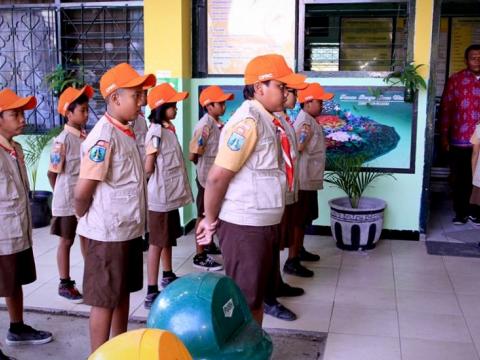Disaster resilient school and community models in Surabaya

Heavy rain started to fall outside their elementary school in Surabaya. When student Aulia Cahyani looked out the window, around 30cm of water had inundated the schoolyard.
“Where should we go?” the confused students shouted.
Aulia shared about the experience at a Child Friendly City talk show in Jakarta recently. She is studying in sixth year and shares how panicked all the students where when the waters rose. She says flooding at the school has happened twice.
Since then, a disaster management team has been established in her school and Aulia became a member of the evacuation team. Although flooding has not happened since the disaster management team was established, Aulia says she is ready if water inundates her school again.
“I became a member of the evacuation team. My job is preparing the evacuation route, saving student documents, and evacuating school members to a safe place,” says Aulia.
A series of other training activities included: risk assessment, capacity building for teachers, developing lesson plans related to disaster risk reduction, and disaster simulations.
Hestiana Iswari, teacher at Aulia’s elementary school says that before the project was introduced, students did not know what to do when there is flood or other disaster.
“Now when there is heavy rainfall, they know about flooding and will get ready to save themselves,” says Hesti.
Wahana Visi Indonesia (WVI) worked with UNICEF and the city government of Surabaya to develop a model to increase the resilience of children and community through the framework of a child friendly city.
WVI’s Simokerto programme manager Willy Sitompul says the project is intended to prepare the community people and children who live in Sidodadi and Simolawang to face any kind of disaster.
“We have established two school-based disaster response teams and two community based disaster response teams,” says Willy, adding that the program targets 38,208 beneficiaries in two villages and two schools.
Widodo, member of community based disaster management team, says his team and community people have prepared contingency plans so that they will know what to do if disaster happens. “We examine the contingency plan, then we do a simulation to know whether the contingency plan is appropriate or not,” Widodo says.
He also explained that the team encourages people to do disaster mitigation efforts like cleaning the river, training, and placing signs in the community about how to live to minimize the potential of disaster.
Agus Pramono, bureau head of Surabaya Coordinating Unit for Disaster Management says that he will develop the programme that is initiated by WVI.
“We will replicate both community based disaster management and school based disaster management in Simolawang and Sidodadi Villages. These are good models,” he says.
I Made Sutama, representing UNICEF, says that the innovation done in Surabaya could be a model for other cities or districts, which eventually could be adopted by the national government to implement in other cities and district.
“To my knowledge there has no city or district who has implemented this kind of innovation,” Sutama says.
Deputy Minister for Child Growth and Development Ministry for Women Empowerment and Child Protection, Lenny N. Rosalin, expects that from the two school models there will be 250,000 disaster resilient schools and from the two disaster resilient villages there will be 72,000 disaster resilient villages in Indonesia.
“We have two, but the two will be amazing leverage if we could make them as models villages,” says Lenny.
Grant profile
Grant Project Name: Disaster Resilient School and Community Models in Surabaya
Funded by: UNICEF
Time frame: 1 October 2014 - 31 Oct 2015
Purpose and Objective: Climate change has become one of the factors contributing to the increasing number of disaster and to address the issue of climate change as well as to minimize the impacts of those disasters, adaptation action is required. Children are the most vulnerable group affected by disasters, therefore it is important to ensure children rights on survival, development, protection and participation whether in a normal situation or in emergency situation.
Disaster risk reduction interventions need to address the issues of children through the eye of the children. That is why Wahana Visi Indonesia, special partner of World Vision Indonesia, together with UNICEF and the city government of Surabaya develop a model to increase the resilience of children and community through the framework of child friendly city.
